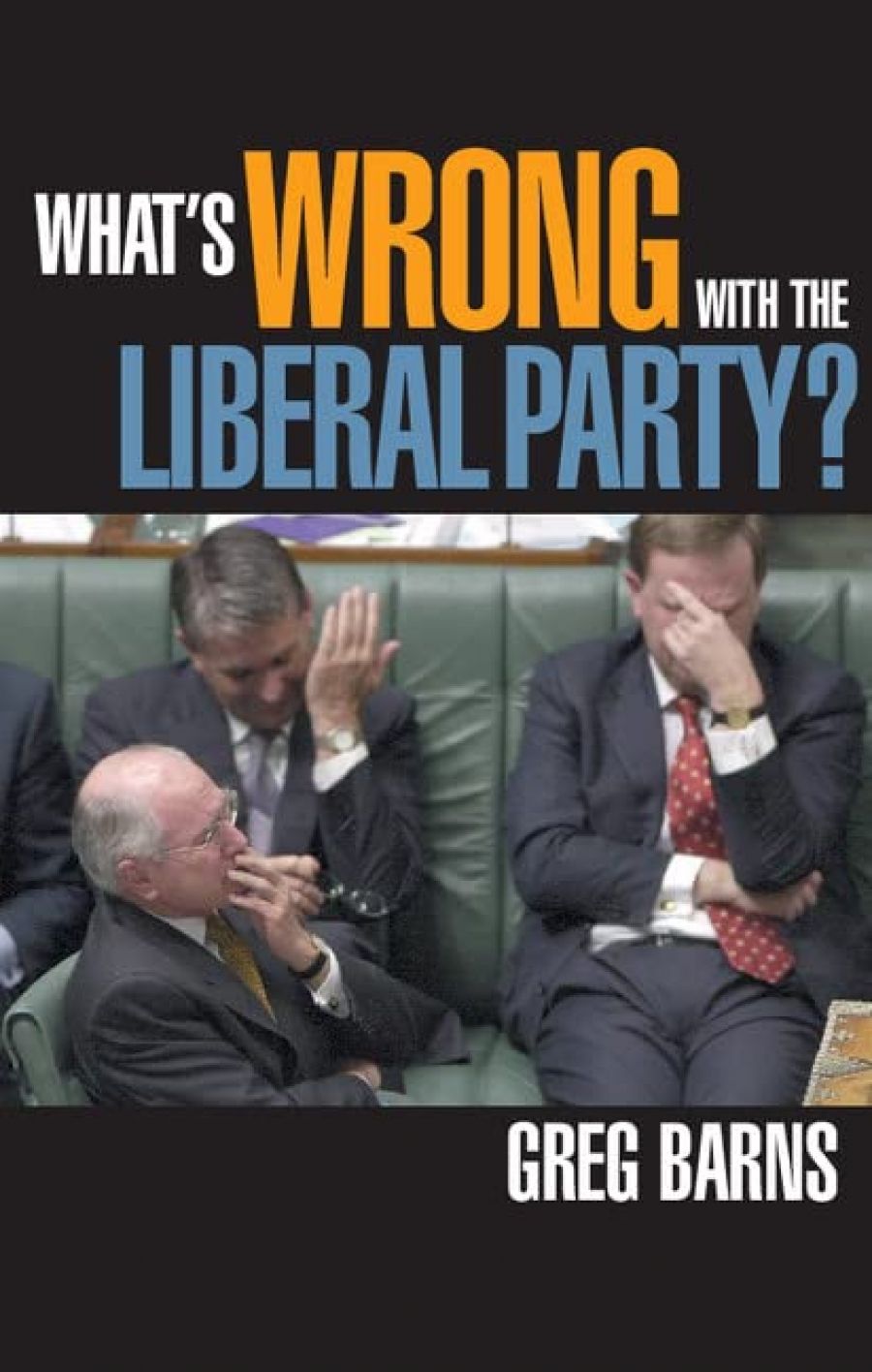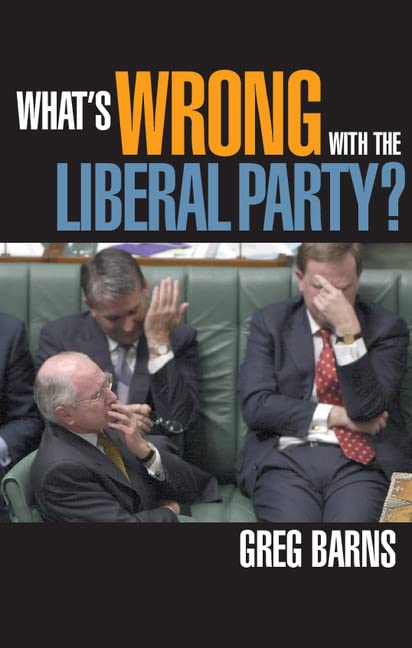
- Free Article: No
- Contents Category: Politics
- Custom Article Title: Dog whistle politics
- Review Article: Yes
- Article Title: Dog whistle politics
- Online Only: No
- Custom Highlight Text:
Greg Barns shares with Pauline Hanson the distinction of having been disendorsed as a candidate by the Liberal Party. Hanson was deselected in 1996 on the grounds of racist remarks; Barns was removed in 2002 for protesting against the ruthless policies of the Liberal government towards sea-going asylum seekers. This is perhaps a measure of the trajectory of the Liberal Party under John Howard, which provides the central theme of Barns’s study, What’s Wrong with the Liberal Party?
- Book 1 Title: What’s Wrong With The Liberal Party?
- Book 1 Biblio: CUP, $29.95 pb, 168 pp
- Book 1 Cover Small (400 x 600):

- Book 1 Cover (800 x 1200):

At a glance, this may seem an odd question to ask about the contemporary Liberal Party; it is more the sort of question one should be asking about the Australian Labor Party. Provided the Howard government sees out its present term, it will have lasted longer than any of its Liberal predecessors since Robert Menzies, and Howard will rank next to Menzies in the hierarchy of successful Liberal leaders. At this stage, the prospects for a fourth electoral victory appear promising, ensuring that Howard would eclipse Bob Hawke as the second longest-serving Australian prime minister. If electoral achievement is the measure of political merit, then there is not much wrong with the contemporary Liberal Party.
It is this assumption that Barns challenges in this provocative and intelligent book. In essence, Barns argues that the Liberal electoral achievement has been the result of a Faustian bargain, with the devil’s due being the soul of the Liberal Party. Faust/Howard, having already drifted from the liberal creed of the Liberal Party, was ripe for the devil’s machinations. He therefore succumbed to the populist temptations thrown up by Hansonism and a container ship full of rescued refugees, a surrender that brought great electoral rewards. This study of the fall is introduced by a brief account of a past Liberal golden age, and is followed by some informed and provocative speculations about the Liberal future.
Barns locates this golden age during the time of Menzies when, according to Menzies’ dictum, the Liberal Party ‘march[ed] down the middle of the road’, an era when not only were policies moderate but real debate was encouraged within the party. This age, though a little less golden, continues through the Fraser period, with Barns being a bit vague about when it ends. This is because he is uncertain as to whether the defining characteristic of Australian Liberalism is the espousal of moderate policies or the pursuit of a small ‘l’ liberal philosophy, the distinguishing feature of which is tolerance. If it is the former, then the age ends with the Liberal Party’s commitment to neo-liberal economic policies in 1984; if the latter, then it ends in 1996 with the coming to power of Howard, a neo-liberal in economic policy, a conservative in social policy and a leader intolerant of dissent.
Golden ages, anyhow, are always doubtful things, by definition gaining their allure through the haze of time. A good case can be made that Menzies was not a liberal Liberal until he could afford to be – that is, only after H.V. Evatt had been destroyed and the Labor Party severely impaired as an effective opposition. And the jury is still out on whether Malcolm Fraser’s contemporary liberalism is congruent with his performance as prime minister. Politicians often remake themselves in retirement – witness the modern Tim Fischer.
There are interesting asides on the future of the National Party and on the paradox of a situation where we have a dominant conservative coalition in Canberra and Labor governments in every state and territory. For the Nationals, Barns sees only a bleak and diminishing future: a party in decline for the past generation, and now under increasing assault from a resurgent rural Liberalism and parochial independents. But the success of the Liberals in rural seats serves to entrench the dominance of the right wing within the Liberal Party itself. Barns tends to dismiss the federal/state paradox as simply the result of a coincidence – that ‘the political cycle [is simply] in tandem across the six states and two territories’. Given the overwhelmingly ‘administrative nature’ of state politics, a Liberal rhythm will in time reassert itself. This, however, ignores the point that a series of Labor state victories presaged Labor’s federal triumph in the early 1980s and, similarly, a succession of Liberal state triumphs foreshadowed the Liberal federal achievement in the mid-1990s. Might not the Labor state successes at the turn of the century have prefigured a federal triumph for Labor, aborted by the contrived and catastrophic events of the second half of 2001?
But the book is focused on John Howard. Indeed, the author is rather obsessed with him, just as, in perhaps the most original chapter in the book, Barns shows how Howard and the Liberal Party remain fixated on Paul Keating. Unlike Hawke, Keating threatened the very essence of the Liberal Party – its ownership of Australian patriotism. ‘Keating,’ writes Barns, ‘attacked the very heart of the Liberal Party without apology, skewering the conservative side of patriotism’ by attacking the symbols that were sacred to it: flag, monarch and the colonial land settlement. So great was their antipathy that the Liberals pursued Keating long after he was politically dead, as though he were some kind of ‘undead’ who had to be nailed, if not with a cross, then with his controversial piggery.
Using personal anecdotes and an insider’s sense of the party’s course, Barns nevertheless subscribes to what is rapidly becoming the received wisdom on Howard’s sustained electoral achievement: ‘Howard … follow[ed] his gut instincts in an unrestrained way and provide[d] Hanson sympathisers and supporters with a political leader who could empathise with their fears and thoughts, but in a way that looked polished in comparison to Hanson’s reactionary shrillness.’ Barns analyses how Howard used the issues of race and immigration as ‘totemic opportunities to prove that he and his party were a better proposition for voters tempted by Hanson and One Nation’. From this flowed a set of policies subtly crafted to appeal to the racism, xenophobia and anti-élitism embedded in Australian culture: the modification of Aboriginal land rights; the abuse of the élitist black-armband view of history; the castigation of the authors of Bringing Them Home; the derailing of effective reconciliation; and, ultimately, ‘the Liberal Party’s capture and harvesting of the virulent One Nation sentiment … at the expense of asylum seekers, and in particular, those who have sought to enter Australia in leaky boats’. Thus we had the Tampa incident, a self-serving drama designed explicitly for electoral ends, and the fabrication of ‘the children overboard’ affair – together providing perhaps the most sorry episode in modern Australian history.
If this orthodoxy becomes accepted, it will tarnish irretrievably the historical reputation of the great sorcerer, as well as that of his apprentice Philip Ruddock. But for the moment, it leaves us with the Coalition electorally dominant both at the top and bottom ends of town, though surprisingly, given much Liberal mythology, not in the middle reaches. Barns shows that the Coalition holds over sixty per cent of both the fifty lowest-income seats and the fifty highest-income seats in Australia. Support for the Coalition in the latter is traditional and unsurprising; it is Liberal success in twenty or so blue-collar, lower-white-collar outer metropolitan seats that has been crucial to Howard’s victories. And it is here that the modified One Nation appeal of the contemporary Liberal Party – ‘dog whistle’ pitched to these particular electors, as Laurie Oakes once memorably put it – has had greatest resonance.
But the very need for dog whistle politics – pitching a message to a particular group of voters that other voters do not hear – suggests the inherent contradictions in the electoral alliance underlying the present Liberal success. Barns discusses a number of these contradictions: the globalising imperative for increased immigration, recognised by much of the economic élite, as against suspicion of immigration in ‘the new territories’; the business élite’s desire for increased enmeshment with Asia, as against suspicion of all things Asian in ‘the new territories’; the tough mutual-obligation régime in social welfare, welcomed by many in ‘the new territories’, but seen as a threat to social cohesion by many of the liberal intelligentsia.
But none of these seems politically unmanageable, particularly for the shrewd operator that Howard has proven to be. While recognising the hip-pocket sensitivities of voters in ‘the new territories’, Barns does neglect the range of economic issues that might jolt these voters from their present allegiance. On the other hand, he tends to underrate the potential that anti-terrorism provides in underwriting a continuing Liberal hegemony, in much the same way as anti-communism underwrote the Menzian hegemony.
As Barns notes, much may depend on the succession. He cannot quite make up his mind whether a Peter Costello succession would see a return to a more centrist and liberal party. Costello has supported the republic, walked for reconciliation and seems more Asia-attuned than Howard. But the limited, reticent and possibly lazy Costello might well disappoint. With Tony Abbott, ‘the closest thing to a Thatcherite in the Howard government’, Barns has no doubts. In his view, Abbott identifies wholly with Howard’s ideology, his conservative populism and his strategy, and would ensure continuity, though Barnes suspects his leadership would be highly destabilising given his ‘abrasive’ personality, his ‘legion of enemies’ and his Manichean view of the world.
It is a measure of his courage that Barns ventures so many predictions about the future course of Liberal politics; it is also a measure of his understanding and sophistication that these cautious predictions are worthy of serious debate. If his analyses, along with his decision to join the Australian Democrats, reflect a despair about the future of liberalism within the Liberal Party, they may yet stimulate that depressed and depressing liberal wing to renew its struggle for the mastery of the party. Yet such a scenario is unlikely until electoral defeat opens up the Liberal Party to new possibilities.


Comments powered by CComment